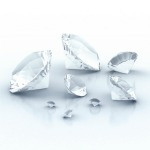 Well, the answer, it would seem, is it depends on the color.
Well, the answer, it would seem, is it depends on the color.
I grew up with the concept that the more pure the diamond–the more clarity and clearness without flaws–the more rare it is, and therefore, the more expensive.
And, a little research on the Internet seems to confirm those old thoughts.
Sure enough, yellow color in a diamond is considered a negative, an impurity. Something about too much nitrogen.
And brown diamonds are firmly lodged at the bottom of the desirability list.
But last week I noticed an ad. It said “Bring a little sunshine into your day. Buy a yellow diamond.”
I was intrigued. Marketers were actively choosing words to increase the desirability of these less-than-top-quality diamonds, to enhance their value, to sell them.
Obviously, for as much money as possible.
Earlier
Two weeks earlier, I had seen an advertisement for “chocolate diamonds,” a clever description to make lowly brown diamonds sound attractive.
And, although a brown color in a diamond makes it the least enticing, an ad describing them as chocolate diamonds makes them, for me, tantalizing.
The chocoholic in me wants one.
Isn’t that an interesting point about words? The power of effective ones, paired with things we find joyful, fun, or addictive, is evident.
The context with which we surround something unattractive or unappealing adds considerable value (or not) to its perceived beauty. In this example, by using associative words like ‘sunshine’ and ‘chocolate,’ the previously identified inferior product – a yellow or brown diamond – becomes an alternative to the conventional and its desirability goes up.
People are like diamonds
They are multifaceted with varying degrees of clarity and color.
I would be happy to be classified as a chocolate diamond – a chocolate anything is decadent and divine, in my well-considered opinion.
I love all things stirred with chocolate—nuts, caramel, etc.
On the other hand, unlike the diamond, I do not want to be regularly scrutinized with a jeweler’s loupe, that ancient tool for determining color, clarity and the smallest of flaws.
Jewelers regularly use these monocular, handheld tools in order to magnify gemstones and other jewelry they wish to inspect. One that magnifies 10X (times) is standard for grading diamond clarity. This is the ultimate level of magnification that affects the grade.
The jeweler examines the diamond under strong light using the loupe. He peers at the center of the diamond, looking closely for black spots or cloudiness that could reduce the diamond’s brilliance.
I have a friend who has an imaginary loupe
She uses it constantly. Everything is examined with it closely and carefully. I would prefer she use it only on diamonds, but that is not the case.
She reads my blog and comments, “I so appreciated your article regarding age. I’m going to remember that – but are you aware you had a typo in paragraph four, line three?”
On another occasion, “Thank you for the surprise birthday luncheon you held for me. Wasn’t it fun? But why didn’t you invite more people?”
Or it might be, “Gee, I love that outfit, Anabel, but your lipstick is a shade too bright.” And then she rolls her eyes at my poor judgment.
Is my judgment inferior to hers, I wonder? And I am left feeling rather more self-critical of others and myself than I would prefer while I remain quiet even though I’m not feeling quiet. At all. I do not like to direct my disgust at anyone.
Paul Ekman, a guru on emotion, asserted at a recent neuroscience convention, “It is not anger which is the most destructive emotion. It is disgust.”
I agree with him
Interestingly, this emotion encompasses a wide range of feelings from mild denigration to the detestable to the deplorable and finally the despicable. All are variations of disgust.
I think the “d” emotion is responsible for the dissolution of partnerships, of marriages, and friendships.
Can you think of instances in your own life when the “d” emotion interferes with the intimacy of a relationship?
With the cooperation and collaboration needed for a partnership, I wonder if it might not be improved with the “g” emotion – gratitude.
We need to be careful of the depth of our examinations, the words we use, the opinions we form. In our day-to-day relationships, it isn’t helpful to be jewelers – examining with precision, looking for flaws, and grading our friends and loved ones according to them.
Personally, I’m taking a pledge to tell my friends how many things they do right! How many things delight me? How many things make me laugh? I want their sparkle to stay bright.
I want people around me who will, like the careful jeweler, help polish the facets I have, maybe celebrate my strengths with a gentle sudsy bath, or perhaps give me the occasional stringent dash of ammonia.
But I want to avoid a flood of chlorine or any harsh chemical, which diminishes my cut, my color, and my clarity.
And I’ll dream about chocolate diamonds and think of yellow ones on a sunny day. And marvel at those wordsmiths who, just by planting a thought here or there, can change the way we see things.
Let’s keep our relationships bright.
What do you think? Do you have friends like this? Who criticize and point out your faults? How do you handle them? And do you make a point to see the goodness? Tell us in the comments!
And please, if you enjoyed this article, share it with your friends on Facebook, Twitter, Google+ and even Pinterest – this is important information all parents could benefit from. There are sharing buttons below.
[…] top, she wore no jewelry except a wide strapped bracelet watch about an inch wide. It dripped with diamonds—at least I think they were […]